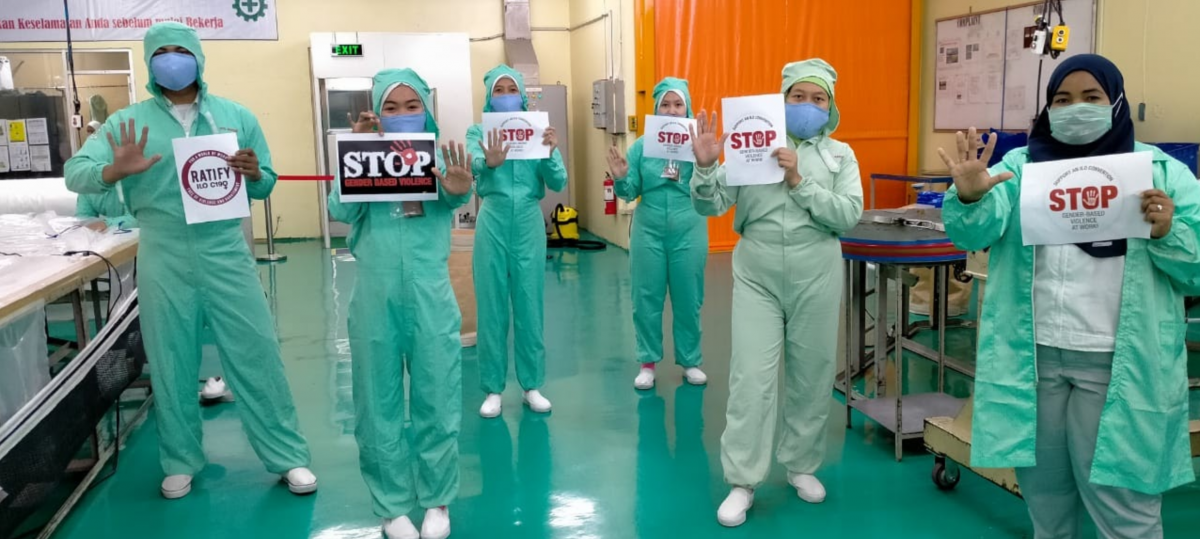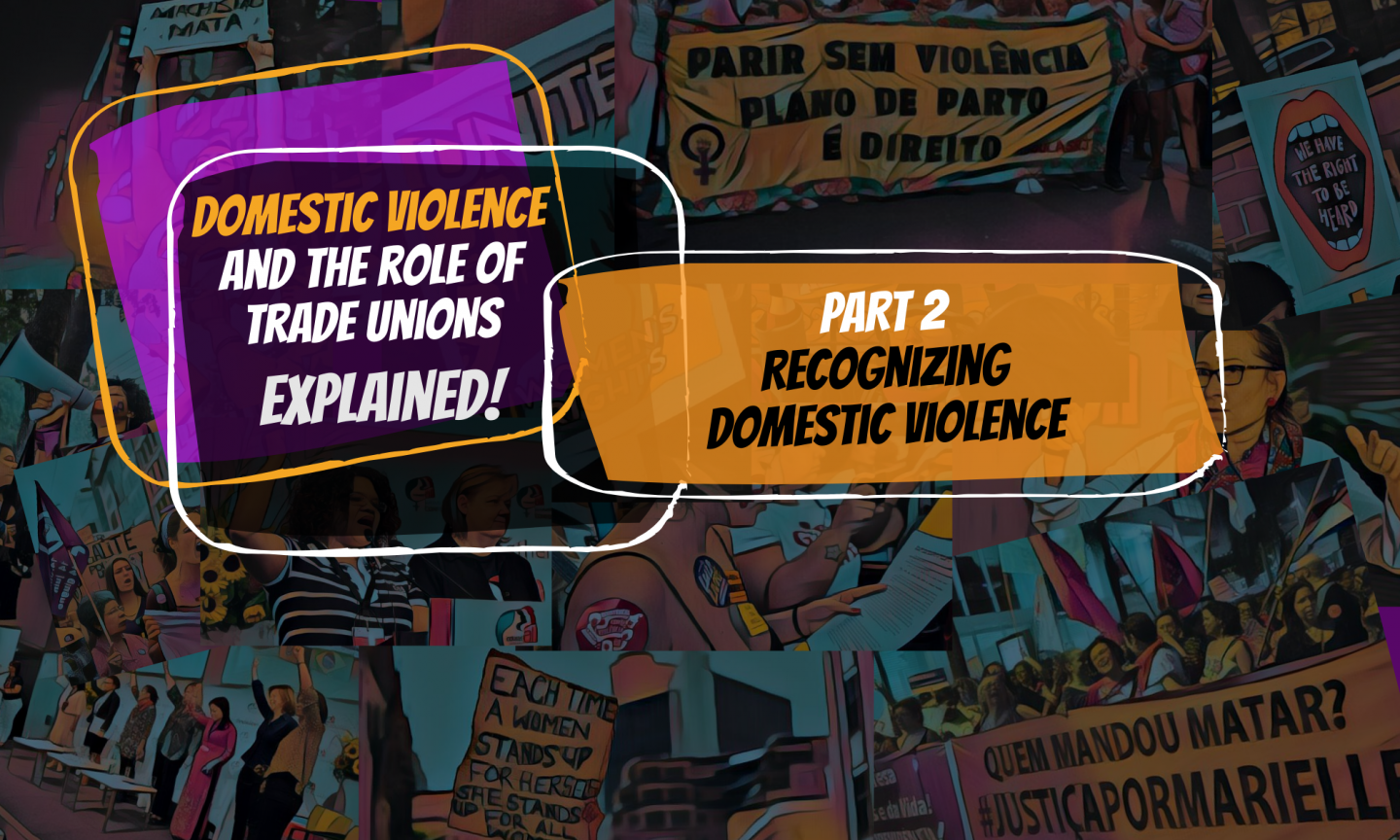23 February, 2021PART 2: "Domestic violence and the role of trade unions explained". We cannot fight domestic violence if we are not able to recognize it.
Although domestic violence may originate in the home, it can spill over into the world of work. Domestic violence is also a health and safety issue, representing a risk for the health and safety of the victims/survivors, as well as their co-workers.
8. Why has domestic violence increased during Covid-19?
There has been a global increase in reports of domestic violence during the Covid-19 pandemic.
The social consequences of the outbreak and related confinements with a loss of social interactions, may have increased tensions inherent to forced cohabitation and increased the risks of domestic violence.
Domestic violence, often committed by men, is deeply rooted in patriarchal masculinities that lead to power and control of men over women. As the crisis and the uncertainty at individual and household levels unfold, perpetrators of violence might want to reassert control and express frustrations caused by the lockdown through increased episodes of violence.
The economic downturn generated by Covid-19 with increased unemployment and loss of income, are particularly dangerous for women in abusive relationships, as economic control is a key tool for abusers. Financial insecurity may force victims to remain with their abusers. It is therefore crucial that governments prioritise intimate partner violence in all parts of their public policy response to the Covid-19 pandemic
Sources: UN Women, Brief COVID-19 and Ending Violence Against Women and Girls; OECD, Women at the core of the fight against COVID-19 crisis
9. Do alcohol and drugs justify domestic violence?
There is no excuse or justification for domestic violence. Attacks against women are the legacy of women being seen as objects or as property. Abusive partners are often protected by a certain level of social acceptance of violence against women being “normal”.
Stress, drugs and alcohol are factors that increase the risk of domestic violence, and may trigger attacks. But domestic abuse cannot be blamed on them. Many people are stressed, and use alcohol or drugs and are not abusive, and neither are any an excuse for any form of abuse.
There is also a widespread myth that domestic abuse is a ‘crime of passion’, a momentary loss of control. But domestic abuse is rarely about losing control, it is about taking control. The abuser has control over whom they abuse.
Source: Women's aid
10. Can the behaviour victims/survivors justify domestic violence?
Too often the victims/survivors are blamed and abusive men are excused. Perhaps he was reacting to his wife’s provocative behaviour or she was asking for it. The woman may be blamed for bringing it on hersel’.
But there is no excuse for domestic violence. No-one deserves being beaten up or mentally tormented.
This widespread and deep-rooted mentally is dangerous because any reference to provocation means that we are blaming the woman and relieving the abuser of responsibility for his actions. Abuse or violence of any kind is never the fault of the victim/survivor. Only the perpetrator is to be blamed.
Source: Women's aid

11. Why is victim-blaming dangerous and prejudicial?
Despite significant social changes men continue to grow up within patriarchy societies and deeply male dominated culture where violence against women is commonplace and acceptable. Sadly, it is still the case that women report that when they have been a victim, they are not believed, or are blamed for their behaviour.
As for any form of gender based violence, victim-blaming is prejudicial. It serves to excuse and partly absolve the perpetrators of violence. A climate of tolerance towards this form of violence can prevent victims/survivors from seeking help or reporting the violence, and encourage the impunity of the perpetrators. It is essential that anyone reporting abuse is confident that reporting such an incident would be taken seriously and listened.
Source: Domestic violence and abuse: a trade union issue, a UNISON guide
12. Can men be also victims/survivors of domestic violence?
Even though women make out the vast majority of victims/ survivors of violence, men and boys can also be victims. Many male victims/ survivors are reluctant to report it for fear of not being believed or being seen as weak.
13. Why do the victims/survivors of domestic violence stay and not report abuses?
Leaving an abusive relationship is not easy; key components of domestic violence are shame and isolation.
Many women fear not being believed and they fear losing their children, a common threat by perpetrators). These problems, together with imposed social isolation within abusive relationships, low self-esteem, financial concerns and fear of future violence, mean that women may feel that they have no option but to continue the relationship, particularly if there are children or other adults’ dependent on them.
They stay because they believe their partners have the potential to change. This makes the situation very complex and means that there are rarely any simple solutions. They feel still responsible for keeping the family together and for maintaining relationships. Furthermore, the abuser knows how to get to the victim/survivor, how to hurt the victim/survivor, often in subtle ways that may not be understood by others.
Victims/survivors may have to face the prospect of living in temporary accommodation, on benefits and in fear of having the children taken into care. Leaving may mean relocating to an unfamiliar area away from family and friends.
Sources: Unite the Union Domestic Violence & Abuse – a negotiators guide; Domestic violence and abuse: a trade union issue, a UNISON guide
14. What does Convention 190 and Recommendation 206 say about gender-based violence?
The Preamble to the Convention notes that “domestic violence can affect employment, productivity and health and safety, and that governments, employers’ and workers’ organizations and labour market institutions can help, as part of other measures, to recognize, respond to and address the impacts of domestic violence”.
As such, the Convention requires Members to “take appropriate measures to … recognize the effects of domestic violence and, so far as is reasonably practicable, mitigate its impact in the world of work” (Art. 10(f)).
The Recommendation provides further guidance. It states that “Members should take appropriate measures to promote the effective recognition of the right to collective bargaining at all levels as a means of […] mitigating the impact of domestic violence in the world of work” (Pt 4 (a)).
The instrument lists possible measures to mitigate these impacts: leave for victims of domestic violence; flexible work arrangements and protection for victims of domestic violence; temporary protection against dismissal for victims of domestic violence, as appropriate, except on grounds unrelated to domestic violence and its consequences; the inclusion of domestic violence in workplace risk assessments; a referral system to public mitigation measures for domestic violence, where they exist; and awareness-raising about the effects of domestic violence (Pt 18).
Source: ILO Convention 190, ILO Recommendation 206
15. Why is domestic violence also a workplace issue?
Although domestic violence may originate in the home, it can spill over into the world of work.
Abusive partners may follow victims to their places of work or use work-related phone or computer technologies to intimidate, harass or control them, or they may work in the same place as their victims.
Domestic violence can also spill over into the world of work through the stress and trauma it causes to victim/ survivors of domestic violence, impacting their performance at work.
People experiencing domestic abuse have to take time off work as a result of abuse and may be late to work. It affects their ability to get to work because they are injured, threatened or had their car keys or money stolen to prevent them getting to work by their abuser.
As well as affecting the safety of the individual, domestic abuse may also affect the safety of other employees and impact negatively on the working environment. Co-workers experience the negative effects of domestic violence through increased workloads, stress, calls or visits from their co-worker’s abuser, and other potential safety risks. Domestic abuse can create conflict and tension between the survivors/victims and their colleagues.
Measures put in place to deal with the coronavirus crisis, and increase of teleworking, mean that home is the new workplace for many. It's a workplace that's unsafe for women at risk of domestic abuse.
Source: ILO Brief on Domestic violence and its impact in the world of work, 2020; TUC, Support in the workplace for victims of domestic abuse

